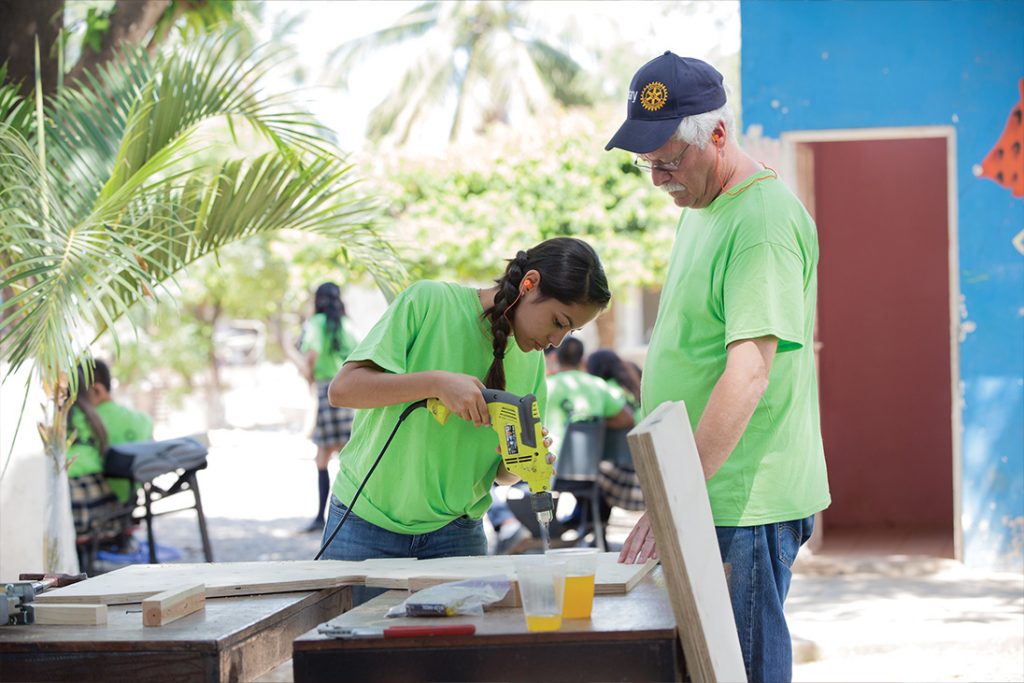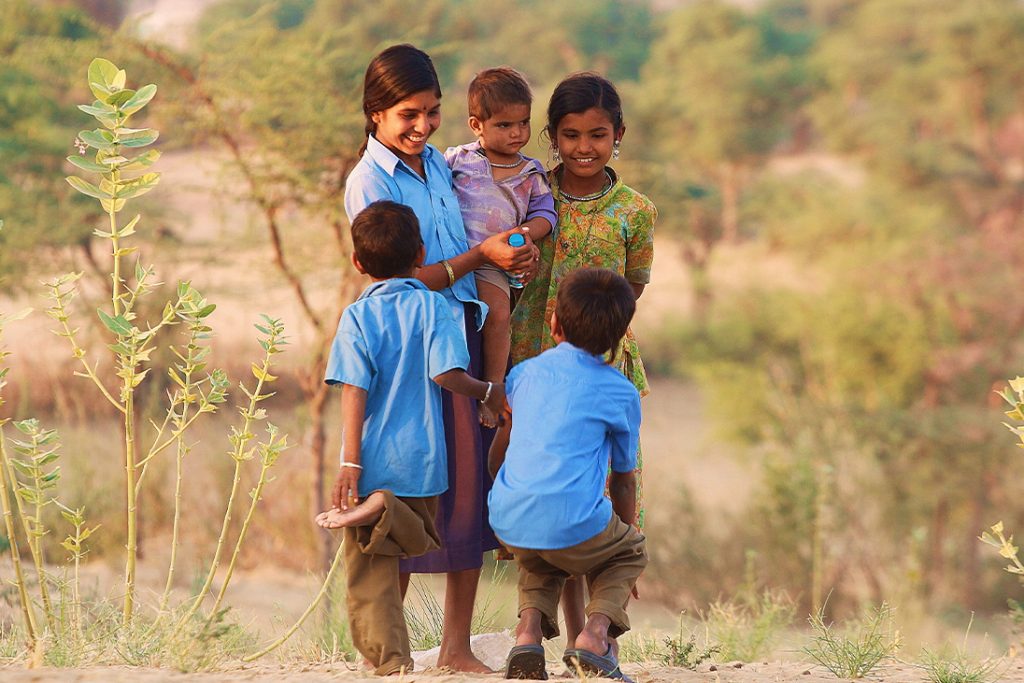On August 14th, Nick and I made our way to Evanston, Illinois — home of our Rotary International headquarters and our new home for the next two years. I must confess, I was incredibly excited to finally sit in my president-elect office. To work from a space that I have respected for years.
It was also nice to work from someplace other than my dining room table. Within the first week, I received a private message from a Rotarian early in the morning. He said, “I am not sure if you remember me. You have spoken at our club, and we met in Hamburg.”
He went on to say that he had a long-shot favour to ask me. His club had a relationship with a scholar, a peace activist in Kabul, Afghanistan — a young woman who was now in danger. Was there anything I could do to help get her onto an evacuation plane?
He told me that smartphones were being confiscated and she was using hers with a private network to mask where she was phoning from. We all remember the scenes as thousands of desperate people were trying to flee from the Kabul airport.
From the comfort of my new office, and sitting behind my big desk, I suddenly felt very small. Who was I, and what could I possibly do?
Only when we live in shared experience like this can we create world peace through understanding.”
A few years earlier, Pat Merryweather, one of our Rotary International directors, introduced me to a peace fellow who held the kind of position that could perhaps influence this type of situation.
Now it was my long shot. I reached out, and that certain Rotary magic that we all know so well took over. It’s the Rotary Peace Fellow who’s the hero of this story.
I don’t know everything that happened, but in less than 24 hours, the young woman was on an evacuation list.
Two days later, we learned she was safely en route to Europe for further processing. Imagine her thoughts that day as the plane launched into the sky.
This, my friends, is the power of Rotary. When the right connections are made, the world aligns and our stories merge. Our differences dissolve, and the only limit to our impact is the barrier of our imagination.


“We need to ask our members what they want out of their experience — and then, we need to provide them with meaningful responsibilities.”
I want to take you to November 9th, 2014. Nick and I found ourselves on the rooftop of a hotel in Berlin, looking down on over one million people. They were there in jubilant celebration at the 25th anniversary of the fall of the Berlin Wall, also known as the end of the Cold War.
Earlier that day, at an event hosted by Past President Holger [Knaack], I met a woman by the name of Tatjana Jury. At the time, 25 years earlier, she was a fresh-faced young radio reporter in the east of Berlin.
She shared: “We had no idea what was going on. My news director was having a nervous breakdown, and I didn’t know what to do.”
So, she took her tape recorder and she went out to explore, because, in her words, “When you want to grab history, you have to grab history.”
She saw thousands of people going back and forth between the East and the West. She saw people chipping away at the barrier. And she went back to her newsroom, and she filed her story.
As I heard Tatjana share this, the power of connection was once again weaving its magic.
On that exact same day, I was also a rookie reporter. I was alone in a newsroom in Windsor, Canada. The alarm bells went off, which meant that something significant was happening somewhere in the world.
I raced over to the old news wire machine and I read that the Berlin Wall was coming down. The Cold War was ending. And just like Tatjana, I didn’t know what to do. But I knew that this was history. And “when you want to grab history, you have to grab history”.
I went into the news booth and I shared the incredible news. Imagine, the two of us being more than 4,000 miles apart yet sharing in a world-altering experience.
When the right connections are made, the world aligns and our stories merge. Our differences dissolve, and the only limit to our impact is the barrier of our imagination.”
So, 25 years later, when Tatjana and I met, we shared some tears. I don’t know whether the news wire story was hers, but I choose to believe that it was.
Only when we live in shared experience like this can we create world peace through understanding. And that world can only manifest when we commit ourselves to equity, human rights, and fairly allocating community resources. Or perhaps, as we all best know it, being fair to all concerned.
As we strive to weave diversity, equity, and inclusion into Rotary, removing the barriers is the key to inclusion. And inclusion is the key to membership. While this may seem like a new call to action, it is not new thinking.
I want you to listen to the actual recording of our founder, Paul Harris, in 1933 at our 24th annual convention:
Rotary is thrown open to representatives of all walks of life, to representatives of all countries and all forms of religion. … Herein lies the genius and the glory of Rotary. … While Rotarians differ in many respects, in two respects they are in perfect accord. We are all in perfect accord.


“Only when we live in shared experience like this can we create world peace through understanding.”
A few years ago, I was interviewed on an American television programme.
Just prior to the start of the taping, the host revealed something striking: He had been a Rotarian for over 30 years, but it was only recently that he “got Rotary.”
He became involved in a project that delivered coats to children in his community. And for the first time, it all clicked.
He saw first-hand the power of service, and he truly became engaged. He even went on to serve as a club president. Imagine — more than 1,500 club meetings before he finally “got Rotary.”
So what lesson does this offer us? We must engage our members.
My hometown, Windsor, is the automotive capital of Canada. I know my way around a shop floor and I was raised in this highly competitive marketplace. When something wasn’t working, we retooled. A plant would shut down for a couple of months to prepare for new parts or an enhanced model.
The past few decades have been tough as plants have shut down due to competitive market forces. Tens of thousands of jobs were lost, never to be replaced.
So what do you do in this kind of a situation? You adapt.
It’s taken time, but our community is now a world-class leader in agribusiness and cutting-edge medical and aerospace technology.
We’re going to actively connect with thought leaders and world leaders in dialogue about how we can work together to address the world’s most pressing challenges.”
We too must adapt and retool. Finding the right “part” to engage each member should be our core function. It comes down to the comfort and care of our members.
A few years ago, my friend Bronwyn Stephens took me to a school in Melbourne. It was there I met a young Interactor named Peter. He told me, “If you want responsible children, you have to give them responsibilities.” Peter was onto something important.
We don’t have a problem bringing members into Rotary. We struggle to keep them. We’re a revolving door — in every part of our world.
We need to ask our members what they want out of their experience — and then, we need to provide them with meaningful responsibilities.
It’s our offer of hands-on service, personal growth, leadership development, and lifelong friendships that creates purpose and passion. These are our responsibilities. If we don’t serve our members, we don’t serve our communities.
And if we don’t provide comfort and care for our members, they may never truly “get” the power of Rotary. And please understand, when I use the term members, it means Rotary and Rotaract. We are all Rotary members. We have been entrusted with leadership in our great organisation.
Now it’s up to us to be brave and intentional in our actions and to let others help us lead.


“As we strive to weave diversity, equity, and inclusion into Rotary, removing the barriers is the key to inclusion.”
I am thrilled today to announce that, starting on July 1st of this year, I have appointed a Rotaractor with the responsibility of becoming a Rotary public image coordinator.
I have officially included Rotaractors on several committees, and during our term, I will begin to assign a select group of Rotaractors as president’s representatives.
President Shekhar [Mehta] launched our Empowering Girls initiative last year, and it has resonated around the world. We will continue this bold effort, recognising that empowered girls become empowered women.
We have less than a year and a half to achieve the board-set target of 30% women in Rotary. We’ve come a long way, and already more than 110 countries have achieved this goal.
That said, we have a long way to go — and 30% is the next stop on the way to 50%. And you know, our members in Rotaract have already achieved this distinction.
Speaking of embracing the different and unique, new clubs — and especially new club models — are vital to growing Rotary.
I need your help with this, and I am asking each of you to help form at least two new innovative or cause-based clubs during your term as governor. Then, and perhaps most importantly, instil in them, and your existing clubs too, our comfort-and-care philosophy.
Let’s make sure we engage our members so they love their clubs and their Rotary experience.
if we don’t provide comfort and care for our members, they may never truly “get” the power of Rotary.”
While we work to innovate Rotary from within, we’re going to also place a special emphasis on raising Rotary’s profile in the world, holding a global impact tour that celebrates our achievements.
We’re going to actively connect with thought leaders and world leaders in dialogue about how we can work together to address the world’s most pressing challenges.
Rotary opens these doors, and we need to harness our connections to deepen these relationships and create new partnerships. And the best part is, this can happen at every level of leadership.
We all feel the impact that Rotary service and Rotary values have on us. Now it’s our opportunity to share that feeling with others.
I remember attending a Rotary meeting in Korea. And while I didn’t understand the language, there was this wonderful moment when they started speaking in unison.
It was clear from the staccato rhythm that they were reciting The Four-Way Test. I felt comfort in that moment — the kind of comfort that comes from familiarity.
Our core values, our traditions, our heritage — these are powerful things that we hold true yet build upon, as we imagine how we can be so much more.
Fifty years ago, an anthem was recorded that included this beautiful line: You may say I’m a dreamer But I’m not the only one. I hear that lyric as a call to action.
We all have dreams, but acting on them is a choice. And when organizations like ours dream big things like ending polio and creating peace, it becomes our responsibility to make these dreams a reality.
Imagine a world that deserves our best, where we get up each day knowing that we can make a difference. You don’t imagine yesterday. You imagine tomorrow.
Imagine a world without polio. Imagine a world with clean water for everyone. Imagine a world free of disease. A world where every child learns to read. Imagine kindness and hope and love and peace.
And that, my dear friends, is why our theme is: Imagine Rotary.
Imagina Rotary
Imaginons le Rotary
Immagina il Rotary
Imajin Rotari イマジン ロータリー
Sangsanghara Rotary 상상하라 로타리
Imagine O Rotary
Hsiang-hsiang Fu-Lun 想像扶輪
I hope that it’s meaningful in all of our languages.
There’s a great line in a song from the Broadway musical ‘Rent’: “Five hundred twenty-five thousand Six hundred minutes How do you measure a year in the life?”
Some of you may be familiar with this play, or some of you may be more familiar with the Puccini opera that inspired it, ‘La Bohème’.
My friend, sitting governor Michelle Bohreer, recently challenged each of us to think about how each one of us gets the same number of minutes.
How we choose to live them is the important question. On July 1, the clock starts ticking. How will you use these minutes?









